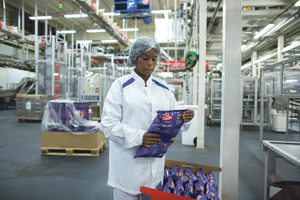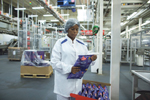There are many things to consider when choosing workwear for employees in the food industry. We have collected 10 key considerations, not only for now, but also in the future:
 1. Level of risk
1. Level of risk
The requirement for workwear when producing food correlates with the risk level in the production. The more perishable the food products, which you are producing, are, the higher the risk level. It is crucial to consider when choosing your workwear setup. The production setup as well as the production process influences the risk level too.
2. Requirements and expectations from your customers
Many food producers experience an increase in requirements from their customers. Retailers, who require the whole supply chain to comply with certain standards for food safety and audit them regularly. What the employees wear during production has a huge impact on food safety, and the workwear setup can easily be standardized to comply with widely used international and national standards for food safety.
3. Protective workwear
The most important function of the workwear is that it protects the products. However, there are exceptions for employees in specialist roles, who have to enter the production area to fix machines for instance. In these circumstances, the garment must protect both the employee and the products in production, as the work sometimes needs to be carried out, while the production is still running.
4. Climate in the production area
Workwear needs to be comfortable for the employees to wear, in order to ensure the best working environment. This means that the climate in the production area should also be considered when choosing workwear. If the temperatures are high, the clothes need to be light whilst still ensuring a high level of food safety. This fabric may not live up to common food safety standards and must be worn underneath the regular coat or jacket, in order to meet the standard food safety requirements.
5. Right fit for everyone
You should consider whether there are any tasks, which require that certain functionalities are added to the workwear. Consider if a standard unisex collection of workwear is sufficient, or whether you want to include female styles as well to ensure that the female employees feel comfortable wearing their workwear. You might also have a need for special sizes, all of which should be considered when choosing workwear setup.
 6. Visual zone markings or monitoring your wearers behaviour
6. Visual zone markings or monitoring your wearers behaviour
Where contamination is a maximum risk, it might be important that the uniforms help to visually control the flow of employees from one area or section to another. Zone markings on uniforms can be helpful, but it is important that it is done in a way that does not compromise food safety. Digitally monitor your wearers’ behaviour by incorporating chips in the garments.
7. Use of logos and corporate branding in workwear
Workwear in food production should be as clean as possible, but strong brands and logos on workwear are sometimes required. It is possible to add logos and visual recognition to workwear without compromising food safety, but considerations that need to be taken into account. It is often required that the logo should be permanently attached, so it can last as long as the garment’s life cycle. The logo should be sewn on or directly embroidered and not transferred.
8. Securing garment cleanliness
Another key consideration when it comes to workwear in the food industry is how you secure the cleanliness of the garment. By incorporating a chip in the garment, it is possible to have a full overview of workwear usage and, in this way, it can be monitored whether the garment has been washed.
9. Peak seasons and high staff turnover
In some food companies, the employee turnover is high and at times the production is influenced by peak seasons, which means fluctuating numbers of employees, who need to be dressed in the right sizes. This should also be considered when choosing your workwear setup. The rule of thumb is that the higher the turnover and the need for availability of workwear in peak seasons is, the less complex your workwear collection should be.
10. Future hygiene ambition
When choosing garments for the food industry, take your future hygiene ambition into consideration. The way you set up and administer your workwear should make you confident that the company will pass audits, not just now but also in the future.
T 0800 616 691
www.berendsen.co.uk

